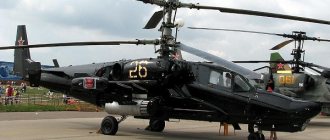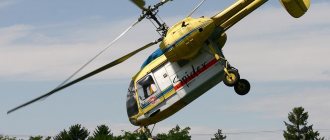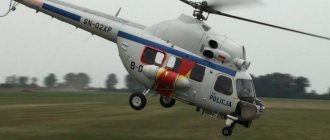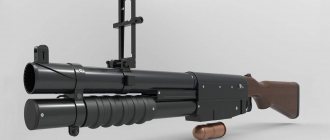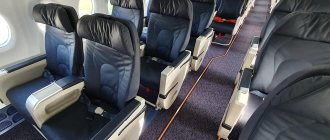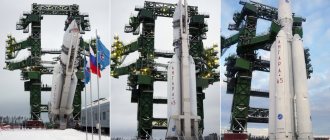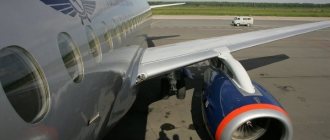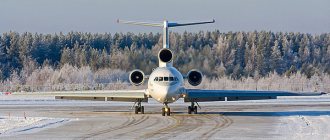The Mi-8 is a multi-purpose and widely used helicopter. Designed and developed by OKB designers M.L. Mile in the early 60s. This Soviet development is the most popular twin-engine air transport vehicle in the world (it is on the list of the most common helicopters in the world history of aviation). It has two directions: military and civil.
In July 1961, the B-8 prototype took off for its first flight. A year later, the second copy of the B-8A was released. In 1967, the Mi-8, which had already been fully modified and changed its old name to a new one, entered service with the Air Force of the Soviet Union. Since the model has proven to be one of the most successful, the current Russian Air Force is also ordering this helicopter. At the moment, this unit is used in fifty countries around the world.
The key modification of the 80s was the developed Mi-8MT. The improved version, or, as it is also called, “product 88”, differs from its counterpart in improved power mechanization (two TVZ-117 engines) and the installed power-type auxiliary structure. True, this option is not so widespread around the world.
In 1991, development began on a new civil air transport helicopter, the Mi-8AMT. At the end of the 90s, the Mi-8AMTSh water transport attack helicopter was developed. In total, over 3,500 copies were produced.
Mi-8 design
The Mi-8 is a single-rotor helicopter equipped with five main rotors and three tail rotors. The main rotors are fixed by vertical, horizontal and axial hinges, and the steering blades, respectively, are of a combined cardan type. The transmission is exactly the same as that of the Mi-4. The all-metal propeller blades include a hollow spar pressed from an aluminum alloy. Attached to its rear stern are 24 compartments with a honeycomb filling made of aluminum foil (forming a profile). The main rotor blades are equipped with an alarm for possible damage to the spar.
An improved antifreeze system prevents the helicopter from becoming icy. It is electrified and has the ability to work in both autonomous and manual modes (feeding 208 volts). In the event that one of the engines fails, the other automatically increases its power. And it does not affect horizontal flight and altitude. Three KAU-30B hydraulic boosters provide high-quality control of the main rotor, and RA-60B steering boosters.
The three-wheel landing gear cannot be retracted. The tail support prevents the tail rotor from touching the ground. Thanks to the external suspension system, the helicopter can transport cargo weighing up to three thousand kilograms. Stabilization of roll, direction, pitch and flight altitude is provided by a four-channel autopilot AP-34.
The passenger version can accommodate up to 18 seats, and the transport version can accommodate 24 seats. The internal climate, heat and cold support are controlled by a KO-50 (kerosene heater) and a specially designed ventilation system. Thanks to navigation instruments and radio equipment, the Mi-8 can fly regardless of weather conditions and time of day.
Depending on the methods of application, there is a huge difference between the modifications. One of the first Mi-8s took off thanks to two TV2-117 engines. Their power was 1500 hp, and the 10-stage compressor was started from the GS-18TO starter-generator. Starting the starter-generator of the first engine is powered by six 12CAM28 24 V batteries, and the second is powered by the starter-generator of an already running engine.
During operation of the GS-18TO engines, a voltage of 27 V is supplied to the main power supply system. Two batteries are installed in the cargo compartment, and the remaining four are mounted in the pilot's cabin. Although their capacity is small, it still does not interfere with powering five engine starts in turn. They deliver current in excess of 600-800 amperes, while being charged from generators (direct current) and can automatically turn on and off. This ability is made possible thanks to differential minimum relays (control of generator operation).
The PT-500Ts converter powers gyroscopic devices with a three-phase voltage of 36 volts. The SGO-30U generator supplies single-phase current (208 V) to the heating elements of windshields and propellers. Two single-phase transformers TS/1-2 and Tr-115/36 depart from SGO-30U. The first powers navigation equipment, and the second powers transmission and engine control devices. In case of malfunctions and failure of the SGO-30U, all equipment switches offline to the PO-750A converter.
Later series Mi-8MT, Mi-17 and others differ significantly from the base model. The installed TV3-117 engines are much more powerful. The air supply to the starters is provided by the AI-9V APU and the STG-3 starter generator. The power supply system produces a voltage of 208 V with a frequency of 400 Hz. It is powered by SGS-40PU generators, which are located on the main gearbox. To start the APU and in case of emergency power supply, 12SAM-28 batteries are installed.
The main power supply is provided by three VU-6A rectifier devices. The first generator is responsible for supplying current to VU No. 1, heating elements of the transformer and propellers, and the second powers VU No. 2 and No. 3, the glass heating mechanism and the ROM of the engines. In some modifications, the TS/1-2 transformer is additionally heated.
If one generator fails, the TS310S04B switches to the second; if both fail, then the PT-200Ts and PO-500A converters are started.
The helicopter is equipped with two hydraulic systems: the main one and the backup one. The NSh-39M pump installed on the main gearbox creates pressure in each of them. Its adjustment occurs with special automatic machines GA-77V. The main system is supported by two hydraulic accumulators, and the backup system by one. Separate electromagnetic valves GA192 include hydraulic power supply for RA-60B, KAU-30B of the common main rotor and two KAU-30B controls of in-line and transverse types.
There are many types of modernization of the Mi-8. They are divided into types:
1. Experienced
- V-8 - the first experimental helicopter with one installed AI-24V gas turbine engine;
- V-8A - the second copy with two TV2-117 gas turbine engines;
- V-8AT is the third prototype created;
- V-8AP is the fourth and final prototype.
2. Passenger
- Mi-8P – passenger helicopter with 28 seats;
- Mi-8PA – modification with GTD TV2-117F engines;
- Mi-172.
3. Transport workers
- Mi-8T – transport and landing helicopter;
- Mi-8TS is an export model for the Syrian Air Force. The design takes into account a dry climate.
4. Multi-purpose
- Mi-8TB;
- Mi-8TV - adopted by the USSR in 1968. The modification includes armoring the cockpit, engines and gearbox hoods, as well as the presence of four Malyutka ATGMs and an A-12.7 machine gun;
- Mi-8AT – TV2-117AG engines;
- Mi-8AV - used to lay mines (up to 200 pieces) against ground forces;
- Mi-8AD – designed for installing small-sized anti-personnel mines;
- Mi-8MT – TV3-117 engines;
- Mi-8MTV – TV3-117VM engines;
- Mi-8MTV-2;
- Mi-8MTV-3;
- Mi-8MTV-5 – modified nose section of the helicopter;
- Mi-8MTKO – installation of lighting equipment and night vision devices;
- Mi-17-1V;
- Mi-8AMT;
- Mi-171 – issued a certificate from the International Aviation Committee. Its modifications are Mi-171A1 and Mi-17KF.
There were also Mi-8TG, Mi-14, Mi-18, Mi-8MSB. A range of special purpose helicopters have been developed for special occasions. Some of them are worth noting. For example, the Mi-8TECH-24 was used for technical and repair work. There was plumbing and testing equipment on board. Mi-8SPA was engaged in search and rescue operations. Mi-8K is an artillery air spotter. The same Mi-8VKP directly represented the airborne command post. The air hospital was represented by a Mi-8MB helicopter.
The Mi-8AMTSh was especially different from all others. The transport-assault type helicopter is widely used by many countries. Equipped with a weapon system and reinforced armor for the cockpit and engine.
DEYUMMRMN-RPYUMYAONPRMSHI lH-8lrb-5/
lH-17b-5
√ YANBPELEMMYU LNDHTHYUZHH BEPRNKERYU lH-8lr, PYUGPYUANRYUMMYU I VERNL NOSHRYU ANEBNTSN OPHLEMEMH. YANGDYUM B PEGSKERYURE DUKEMEYETSN YANBEPYEMYARBNBYUMKH BEPRNKERNB YAELEIYARBYU lH-8, PYUGPYUANRYUMMSHU YNMYARPSYRNPYAIHL ACHPN lNYAYNBYAYNTSN BEPRNKERMNTSN GYUBNDYU MY YAPEDYARB YU KH OPH MEONYAPEDYARBEMMNL SVYUYARKHH yYUGYUMAYNTSN BEPRNKERMNTSN GYUBNDYU.
oEPBSHI ONKER NOSHRMNTSN NAPYUGZHYU √ 1995 Ts. mYUVYUKN YAEPKHIMNTSN OPNKHGBNDYARBU √ 1996 Ts. mYUVKHMYYU I 1995 Ts. BEPRNKER lH-8lrb-5 LMNTsNYYYURMN SVIYARBNBUK B YUBHYUZHNMMSHU BSHYARYUBYUU X DELNMYARPUZHNMMSHU ONYUGYUU BN tPYUMZHHH, TsEPLYUMXX, tsPEZHHH, yHRYUE, aPYUGHKHH, VHKH.
yaEPKHIMNE OPNHGBNDYARBN PUGBEPMSRN MU ybg. BYAETSN ONYARPNEMN NYNKN 100 BEPRNKERNB DK ONYARYUBNY MU SHYYAONPR. PETSKHNMSH SHYYAOXYURYUZHHH √ xMDHЪ, yKhRYUI.
bEPRNKER OPEDMYUGMYUVEM DK OEPEBNGYH TsPSGNB X DEYYUMRMKHYNB BMSRPKH YUAHMSH X YPSOMNTSUAYUPHRMSHU TsPSGNB MY BMEMEI ONDBEYAYE. JNLLLEMNBYU BOPRKNERKUE ONGBKA LHMHMHHHPHPNBure BPEL OHOHDYUMH BEPRNERYU, VRN Nanammn Bufmn OPHEMRHPNBYUMH B SYAKNBHU AN (36 vecti gi 15 YAIIMD). b DEYYUMRMNL BYUPKHUMRE MU BEPRNKERE SYARYUMYUBKHBUCHRYA 36 YAHDEMCHI, 6 KHG MKHU √ KETSINYAZELMSHE. lH-17b-5 NYAMYUYYEM YAKHYARELNI AEYAOYUPYUCHRMNTSN DEYUMRKHPPNBUMH, YNRNPYU ONGBNKYER NYASYYYARBKRE NDMNBPELEMMSHY YAOSYAY VERSHPEU VEKNBEY. bePRNKER NANPSDSERYA KEAEDYNI yakts-300 I ANPRNBNI YARPEKNI TsPSGNONDZELMNYARECH 300 YTS. dK NYASYYYARBKEMKH ONKHYAYU ONYARPYUDYUBKHU B MNVMNE BPEL HYAONKEGSERYA OPNFEIRNP RHOYU SX-16. dK SCHBUYSYUZHHH ONYARPYUDYUBKHU B TsPSGNBNI YUAHME LNFER ASHRE SYARYUMNBKEMN 12 MYAHKNY. rPYUMYAONPRKHPNBYU YPSOMNTSYUAYUPHRMSHU TsPSGNB NYASYYARBKERYA I ONLNYECH BMEMEY ONDBEYAYKH, NYAMYUYUMNI BEYANKHGLEPKHREKEL H YAKHYARELNI YUBYUPKHIMNTSN YAPNYAYU. oPEDSYALNRPEMYU BNGLNFMNYARE OEPEBNGYH DKKHMMNLEPMSHU TsPSGNB BMSRPKH TCHGEKKFYU I NRYPSHRNI YOOYUPEKECH. dKЪ SBEKHVEMHYU DUKEMNYARH ONKERYU lH-17b-5 NYAMYUYUERYA DNONKMHREKEMSHLH RNOKHBMSHLH AYUYULH (DN 4-U AYUNB BMSRPKH TsPSGNBNI YYUAKHMSH HKKH DBYU AYUYU YAMYUPSFKH MU YAOJHYU KEMSHU TEPLYU).
bNNPSFEMMSHI BYUPKHYUMR lH-17b-5 OPEDMYUGMYUVEM DK NTsMEBNI ONDDEPFYKH YASUNOSRMSHU BNIYAY, DEYUMRYU OPH BSHYAYUDYE HKH SHBYYUSHHH, DK NYASYYARBKEMKH OPHZHEKEMNTSN ANLANL ERYUMH. dKЪ GYUYKHRSH NR pkya gpy OPNRKHBMKHYU SYARYUMYUBKKHBUERYA ANPRNBNI YNLOKEYA NANPNMSH (ain), BYKCHVYUCHYKHI SCHYPYUMMN-BSHUKNOMNE SYARPNIYARBN (schbs), sb-26 HKH Yuyan-2b, k166-b 1yu X DPSTSNE NANPSDNBUMHE. dK OPHLEMEMKH B MNVMSHU SYAKNBKHU YUAHMYU YUDYUORKHPNBYUMYU Y HYAONKEGNBYUMKHCH NVYNB MNVMNTSN BKhDEMH. lH-17b-5 LNFER ASHRE SINLOKEYRNBYUM NAGNPMSHLH YAHYARELYULH (FLIR) PNYYAKHIYYYNTSN HKKH GUYUDMNTSN OPNKHGBNDYARBU. bEPRNKER, NANPSDNBYUMMSHI RYUYKHLH YAHYARELYULH, LNFER SHTTEYRKHBMN HYAONKEGNBUREYA OPH OPNBEPEYE TSMYZHNMHPNBYUMH KKHMHI SHKEIRPNOPEDIUVH, TSYUGNBSHU KH METRMSHU RPSAN OPNBNDNB, OPNBEDEMXX SHYNKNTSKHVEYAYNTSN LNMHRNPKHMTSYU. mYUBKHTSYUZHHNMMNE NANPSDNBYUMHE "yuapkhya" NAEYAOEVKHBUER NRNAPYUFEMHE ONKNFEMKH BEPRNKERYU MU ONDBHFMNI SHKEYRPNMMNI YUPRE KH YUDYUORKHPNBUMN Y OPHLEMEMKHCH NVYNB MNVMNTSN BHDEMKH .
oPNBNDHRYA OPNTSPYULLY ONSCHRYUOMNI LNDEPMHGYUZHHH. dK SKSVYEMKH BSHYANRMSHU UYUPYUREPHYARKHY BLEYARN DBKHTSYUREK rb3-117bl ASDSR SYARYUMNBKEMSH by-2500, YU BLEYARN BYAONLNTSYUREKEMNI YAHKNBNI SYARYUMNBYKH (byas) yuh-9 - bya with Safir. lH-17 B RYYNI YNLOKEYRYUZHHH OPNYEK HYAOSHRYUMKH B BSHYANYNTsNPMSHU PYYINMYU RHAERYU. b PEGSKERYURE ASHKH DNYARKHTSMSRSH: OPYURHVEYAYHI ONRNNY DN 6500 L, YARYURHVEYAYHI ONRNNY DN 4500 L, OPNBEPEMY BNGLNFMNYARE GYOOSYAYU DBKHTSYUREKEY B DHYUOYUGNME RELOEPYURSP NR -40th DN +40th MU BSHYANRE YABSHYE 6000 L.
lNDEPMKHGKHPNBYUMMYU LNDKHTHYUZHKH I DBKHTTSUREKEL b-2500 X MNBNI byas ONKSVHR MNBNE ANPRNBNE NANPSDNBYUMKHE X MNBSHE YUTSPETSYURSH MEYASYYE YAKHYARELSH, PYUGPYUANRYUMMSHE lbg KHL. OK. lHK DK YANBPELEMMSH BEPRNKERNB lH-28 X lH-38. schRYU LNDEPMHGYUZHH ASDER BSHOSYAYUREYA OND NANGMYUVEMHEL lH-17b-7.
yNMYARPSYZHH.
nDMNI XG NRKHVKHREKEMSHU NYANAEMMNNYAREI lH-17b-5 (lH-8lrb-5) ЪБКЪРЯЪ ХГЛEMEMХе YNMTHTTSSPYUZHHH DBEPEI X KCHINB.
xGLEMEMYU TNPLYU MNYANBNI VYUYARKH (“DEKETKHMKHI MENYA”). mu lH-17b-5 (lH-8lrb-5) SYARYUMNBKEMSH PUYAHPEMMYU MU 0.4 L KEBYU DBEPE, DNONKMHREKEMYU OPYUBYU DBEPE YARYUMDYUPRMNTSN PUGLEPYU. BLEYARN NRYKHDSHBUCHYHUYA BPSVMSCH TsPSGNBSHU YARBNPNY SYARYUMNBKEMYUOOYUPEKE, NRYPSHBUCHYYUYAJA ONLNYECH TsKHDPUBKHVEYAYNTSN OPKHBNDU, VRN NAEYAOEVKHBUER YANYPYUYYEMKHE BPEL EMH ONDTSNRNBYKH BEPRNKERYU Y ONTSPSGYE KH BSHTSPSGYE, ONGBNKYER KHGAEFYURE PSVMSHU NOEPYUZHKHI. yNMYARPSYZHKH TCGEKFYU NAEYAOEVKHBUER BNGLNFMNYARE LNDEPMKHGYUZHKH BEPRNKERYU H NYAMYUYEMH ETSN DNONKMHREKEMSHL NANPSDNBYUMHEL ON RPEANBYUMHCH ONYSOYUREK. b YAKSVUE SHYAOXYURYUZHHH MU YUSCHPNDPNLYU I OSHKEBSHL ONYPSHRHEL LNFER ASHR NANPSDNBYUM OSHKEGYUYHRMSHL SYARPNIYARBNL. mNYANBYU VYUARE TCHGEKKFYU HLEER ONDMKHLYUCHYYYYA BBEPU MNYANBNI NAREYUREKE, YNRNPSHI ONGBNKYER ONKSVKHRE DNYARSO DK NAYAKSFKHBYUMKH PYUGLEYEMNTSN B MNYANBNI VYUYARKH NANPSDNB YUMHЪ. rNOKKHBMSHHE AYUYH LNTsSR ONYARYUBKЪREYA B OPNREIRKHPNBUMMNL HYAONKMEMXX X I OEMNONKHSPERYUMNBSHL GUONKMHREKEL. cru:
| lNDHTHYUZHH | lH-8lrb-5 |
| dHYULERP MEYASYYETSN BHMRYU, L | 21.30 |
| dHYULERP PSKEBNTSN BHMRYU, L | 3.91 |
| dKKhMYu, L | 18.42 |
| bSHYANRYU,L | 5.34 |
| I love it, JC | |
| OSYARNCN | 7580 |
| MNPLYUKEMYU BGKERMYU | 11100 |
| LYUYAHLYUKEMYU BGKERMYU | 13000 |
| RHO DBKHTSUREK | 2 tsrd yKHLNB rb3-117bl |
| lnymnyare, YbR | 2 U 1639 |
| LYUYAKHLYUKEMYU YAYNPNYARE, YL/V | 250 |
| yPEIYEPYAYU YAYNPNYARE, YL/V | 230 |
| oPUYRHVEYAYU DUKEMNYARE, YL | 715 |
| YAYNPNONDZELMNYARE, L/LHM | 540 |
| oPUYIRKHVEYAYKHI ONRNNKNY, L | 6000 |
| YaRYURKHVEYAYKHI ONRNNKNY, L | 3980 |
| ShYKHOYUF, VEK | 3 |
| ONKEGMYU MYUTSPSGYU: | DN 24 OYUYAYUFHPNB HKH 36 DEYYUMRMKHYNB HKH 12 MNYAHKNY I YANOPNBNFDYUCHYHLH HKH 4000 YTS TsPSGYU B YYUAHME HKH 4000 YTS MU ONDBEYAYE |
| bottom. KhMTNPLYUZHKH: |
| tNRNCPYUTHH: | lH-8lrb-5 (c) xCNPE dBSPEINB |
| lH-8lrb-5 (c) yuKEYAYUMDP lKYUDEMNB | |
| lH-8lrb-5 (c) xCNPE dBSPEINB | |
| lH-8lrb-5 bbya xPYUYU (c) LYYYAHL aPMYAYKHI | |
| lH-8lrb-5 bbya xPYUYU (c) yuMRNM uYUPKHYANB | |
| lH-8lrb-5 bbya xPYUYU | |
| yYUAHMYU OKHKNRNB lH-8lrb-5 (c) aYuAYuY r. |
| YaOHYANY HYARNVMKHYNB: |
| bEPRNKER. lH-8lrb-5/lH-17b-5 DEYUMRMN-RPYUMYAONPRMSHI bYUDHL lHUEEB. lH-8 - 40 KER B YARPNCH bYUDHL lHUEEB. lbg HL. l.k.lHKЪ 50 KER |
sTSNKNY MEAYU. 2012
Helicopter development.
In 1960, OKB Mil M.L. began developing a new transport helicopter that would replace the outdated Mi-4. An experimental prototype designated B-8 made its first flight in June 1961. The helicopter was equipped with one AI-24 gas turbine engine and a four-blade main rotor from the Mi-4. Later, the designers made a number of improvements. The power plant was replaced with two TB2-117 gas turbine engines. The main rotor became five-bladed.
Engine AI-24.
Production and release.
Flight tests began on September 17, 1962. The helicopter fully lived up to the expectations placed on it. Since 1965, it went into mass production under the designation Mi-8. The design of this machine turned out to be so successful that its production and modernization continue to this day. Today the Mi-8 is one of the most common transport helicopters in the world. More than 8,000 cars were produced in various modifications. The helicopter is operated in more than 50 countries around the world.
Mi-8 cabin
By its design, the Mi-8 is a single-rotor helicopter. The fuselage is a semi-monocoque frame consisting of a cockpit, a cargo compartment and a tail boom. The cockpit is three-seater, designed for two pilots and a flight mechanic. The cargo compartment can be adapted for transporting cargo or equipped with seats for passengers. In the transport version, loading is carried out through a double-leaf cargo hatch. The landing gear is tricycle non-retractable. The power plant consists of two gas turbine engines TV2-117A (TV3-117MT), 2x1710 (2x3065) hp. The main rotor is five-blade with all-metal blades. The tail rotor is three-bladed.
Engine TV2-117A.
Helicopter modifications.
There are more than 30 modifications of this vehicle, the main ones being the Mi-8T (transport) and Mi-8P (passenger). The Mi-8AMTSh is an air assault variant with missile and machine gun armament. The helicopter is used to perform a wide range of missions, both in civil aviation and in the air force. Since the 70s, the Mi-8 has been used in many military conflicts in different parts of the world.
Mi-8P (passenger).
Mi-8T (transport).
